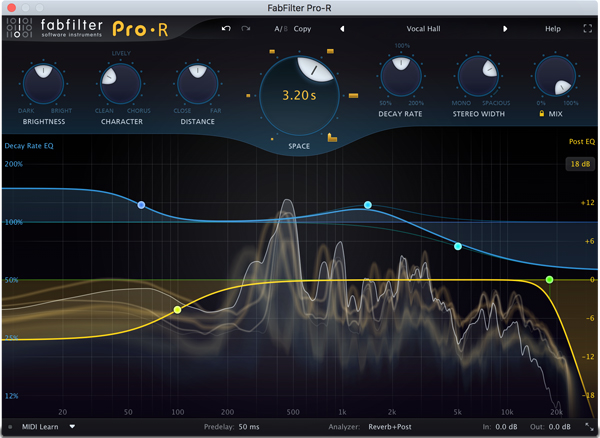|
|
FabFilter Pro-R Reverb Plug-in
|
|
|
 |
| FabFilter Pro-R Reverb Plug-in |
Simplicity starts with the largest control knob placed in the center of the seven controls called Space and it continuously varies the ambience of the selected reverb preset from very small, claustrophobic boxes anywhere up to gigantic large arena size spaces with ten-second (RT60) reverb decay times.
The Distance control is an interesting parameter I figured out when using Pro-R as a send/return reverb on a snare drum using the default reverb preset. The Distance control allows for the precise dimensional placement of the source within the modeled space. I solo'd the reverb return and found, as I adjusted Distance to 0%, the early reflections became brighter, present and more pronounced. As I started increasing Distance, it sounded as if I was moving away from the source; the source receded from my listening position and the stereo reverb started to buildup in length, size and density with some high frequency loss (simulating the way sound propagates in air) and I could also hear the flutter echoes bouncing off the virtual space's hard surfaces.
The Distance control and its effect are easily heard when using tempo-synced pre-delay feature since the delay's echo can be set to merge into the early reflection part of the reverb's sound.
I liked the Decay Rate control because it provides 50% to 200% of fine tune adjustment for the Space control. It comes up at 100% of the preset's decay time with the final value always indicated within the Space knob. The Brightness knob, unlike an equalizer, mimics and adjusts the high frequency absorption of the modeled space of the selected preset. So for a virtual room preset of a given RT60 you may, in affect, "refurnish" the space with more or less absorptive materials and surfaces--curtains, couches, rugs etc. by way of the Brightness control.
The Character introduces modulation into the synthesized ambience to randomize the reverb tail's sound. At 100%, the effect sounds like a chorus with both amplitude and phase changing--good for "blurring" the sound of vocals to make their pitch center somewhat ambiguous.
I like adjusting Character when using a "larger than life" Stereo Width control setting (goes from mono to 120% stereo) where the reverb returns appear nearly outside of the physical position of the left and right speakers. This is an awesome effect yet I had no worries about phase coherency and mono capability.
Decay Rate and Post EQ
My all-time favorite parts of Pro-R are the six-band Decay Rate EQ and Post EQ features. Both of these EQ curves--a blue trace for Decay Rate and yellow for Post EQ--are superimposed on top of a beautiful graphical spectrum analyzer depiction of the currently running reverb. Touching either curve enables editing of it only.
With Decay Rate, you can control the length of the reverb decay time at up to six different frequency points or nodes. It uses a choice of up to six individual low/high shelving filters, peaking EQ, or notch filters to boost or cut the reverb's decay at the selected frequency. Typically in reverberant rooms, the high frequencies decay faster than the lower frequencies and with Decay Rate, you can complete redesign the synthesized reverberation's timbral nature by way of Decay Rate EQ. Awesome!
Each of the six filters has controls for changing frequency, Q, and select one of the four aforementioned filter types. Amount in dB is denoted as a percentage up to 200% of the possible decay rate. It is easy to emphasize the decay rate at certain frequencies while getting rid of others. This is all new to me but I see using this to develop very unique drum sounds and samples, synth patches and special effects--who knows.
Decay Rate EQ in conjunction with Post EQ applied to the output of Pro-R opens up many great sound design ideas immediately! Capable of six bands that each automatically 'color-coded' for editing clarity, it uses the same kind of pop up window as the Decay Rate EQ for each band. When you mouse over its node, a window pops up to show: frequency, Q, boost/cut in dB, and either a peaking, high shelf, low shelf, or high and low cut filters.
FabFilter's Pro-R sells for $199 MSRP downloadable, has a full-screen mode that is great for teaching about reverb or just "showing off" on a second monitor. It has Retina support for OS X and High DPI support on Windows and also supports common Pro Tools hardware control surfaces and has MIDI implementation via the MIDI Learn feature. It runs VST, VST3, AU, AAX Native, and RTAS in 32-bit on MAC OSX 10.6 or higher and Windows 10, 8, 7, or Vista.
I have to say I look forward to using Pro-R on all future music mixes and I'm highly recommending it to anyone who is looking to design special reverb treatments very specific to their music. Pick out a preset that's close and dive in and tweak away--you're going to love it!
More at: www.fabfilter.com/products/pro-r-reverb-plug-in.
|
|
|